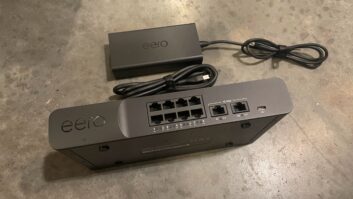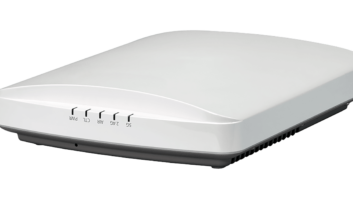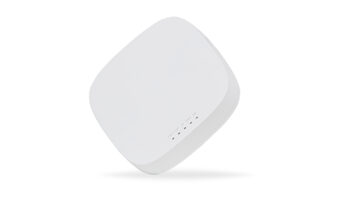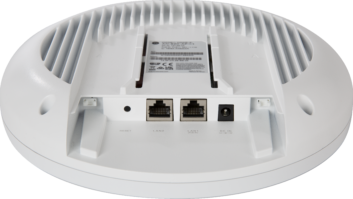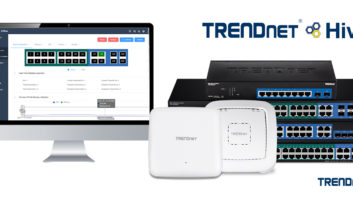Our experience with Internet connectivity today is a lot like our expectations for the kitchen sink. When we turn on the faucet, we always expect water to flow. So its no wonder that we feel a panic akin to the pipes being frozen when we cant tap into the eternal spring of the World Wide Web. All it takes is for the Internet to go down and suddenly it becomes apparent how lifeless our computers seem without access to the vast quantities of information constantly running in the background.
Take that scenario and apply it to the increasing amount of electronic media that we rely on in our homes, and you will discover the crucial nature of the type of faucet we use to reliably and consistently pour forth our music, videos, weather reports, games, e-mails, and various subsystem controls. There is a shift in mindset occurring along with the proliferation of iPods, Media PCs, TiVos, and countless other storage devices: We want access to all of our media and information through a single access point. And that access point should provide two layers of control, one that reads our minds and automates a sequence of events at the press of a single button, and another, deeper layer that allows us to extract information and functionality through a system of menus. Fortunately, control interface technology is ready to serve both of these needs. Through the careful selection and programming of a range of keypads, touch panels, and the hybrid products that lie between these two categories, everybody who lives in a house can feel like the control system meets their usage ideals.
Yes, there was a time when only one button per function was needed on a control device. Then, as control became more complex as the functions it served became more numerous, the press and hold option came into vogue. However, that proved frustrating, and was all but abandoned. Today, thanks to more flexible keypads and more affordable small-scale LCDs and touch screens, the user interface is becoming more complex and more simplified at the same time. Now a button can function as either a direct trigger for an action or provide access to another layer of menu options. Many would say this streamlined approach to advanced control was made possible by the single-most significant recent evolution in user interface design, the iPod. Not only has this device trained some 70-billion purchasers of the product on how to access multiple gigabytes of information with a few simple clicks, but it also fed users desires to see track names, album titles, album art, and basic volume and transport controls all on one tiny screen.
As a result of the desire by end users to know whats going on with their control system (fancy that!) two-way control is now all the rage. For many years, our industry operated a little bit in the dark, we pushed a button and hoped something would happen, and most of the time it did, but it was a one-way world, observed Paul Starkey, executive vice president of ELAN Home Systems. Now with all the intelligent devices that provide data, its very important for user interfaces to show what song is playing or provide another level of easy navigation for the client.
Content is certainly a driving factor in the advancement of control systems. Both the Internet and the iPod are portals to vast amounts of content, and that has increased the general publics expectations for seamless access to heaps of information without consideration for the source or format. The user interface should be completely transparent to the end-user, emphasized Josh Stene, technical director of Crestron Electronics. They shouldnt have to think about where the content physically is derived from, they should be able to push a button, select the items that they want, and whether its audio, video, or some sort of online streaming content, it all should be available.
It is in fact the type of content or control data that can determine the hardware used in an application. For instance, if youre controlling a lighting system, generally you want to treat a keypad more like a light switch, Stene said. When youre coming into a dark environment and you reach over onto the wall, it has to be tactilely familiar to you so you can turn the lights on or off just by touch. One, two, or four buttons on a keypad is really about the maximum that I would recommend for any point of entry or egress.
The button count goes up when audiovisual control is added to the keypad, but the limitations in terms of how many transport controls can be included in a keypad layout, plus the lack of meta data, usually make this solution most suited for secondary rooms in the house. At that demarcation point is where I would start to consider alternate interfaces, as more and more audiovisual devices are menu-driven in nature, Stene said. Those types of devices allow you to tunnel in through things like artist, album, genre, various custom and user-oriented play lists, and you really need feedback for you to be able to make those types of selections. So at that point, you want to move beyond a keypad and start looking into a touchscreen environment.
Beyond content considerations, the keypad versus touch screen debate is also an aesthetic concern. Keypads are optimal to reduce wall clutter. It is typical to walk into a multi-million-dollar home that does not have automation and find wall switches with six, eight, 10 different switches on them, remarked Derek Jensen, marketing communications manager for Vantage Controls. These could easily be replaced with one keypad, he said, adding that a similar reduction in clutter is inherent in the use of touchscreens. By using touchscreens, you can get rid of the multiple remotes that you would require to control all of the various components of a home theater, he said.
The basic keypad has long been considered an aesthetically accommodating device, as it fits within a decora wall plate and is inoffensive to most clients and decorators. Not as decorator-friendly are the two-gang keypads with more buttons. Next in the hierarchy are smaller touch panel products with four-inch or slightly larger screens, or hybrids which feature both keypads and an LCD screen, which by their limitations in customization arent often very attractive to interior designers. But fortunately the highest level of control options, the touch panel interface, can be designed with a backdrop that either echoes a motif or maybe even replicates a wallpaper pattern exactly. What we see happening is an evolution away from the buttons, more to the warm and inviting, designer-friendly interfaces, Starkey said.
Some integrators, like Eric Lee, president of Integrated Control Experts (ICX) in Chicago, warm interior designers hearts by collecting fabric swatches or photographing room elements such as stone fireplaces and using the images to create background images for touch panel control screens. As a dean for CEDIAs collaboration in the EST certification program, Lee has placed a great deal of focus on user interface design in the associations education programs. He pointed out that today there is much more time devoted to the design of a user interface than perhaps five years ago, and that today it is something integrators can definitely bill for. To help prove just how design intensive this process is to his clients, Lee creates printed layouts of control pages and binds them in a presentation folder for planning meetings. Well actually sit down, even for the lighting keypads, do an interview, discuss what the possibilities are, give input, listen to their input, and typically a couple of months before were even putting the lighting system in, we already have the program generated, Lee said. It helps form the clients mental model of how that system is going to operate, and that saves a lot of time making changes that you cant bill for on the back end of a project.
No matter what the hardware platform, the mental model is king, and that usually means that ease of use becomes tantamount to advanced functionality. The majority of customers who have a system installed are not interested in using every single feature thats built into their components; theyre interesting in doing the things that are important to them, said Eric Johnson, vice president of technology for Universal Remote Control. If we provide a remote with too many buttons, then the customer cant find the buttons they needvolume and channelbecause theyre looking through the forest of other buttons. Give them a remote that only has volume and channel, and you miss transport controls. If you cant find the basic functions, then thats a failure too. You have to look at the entire system and understand what the activities are, then define and prioritize control functions.
Transport control is one area that has seen some standardization in user interfaces, as the icons for these activities are nearly universal at this point. When you see a button with a triangle pointing to the right, you know its play, observed Paul Kenline, marketing communications manager for Colorado vNet. You can add your own colors and your own style, but the icon use has got to be the same. Nobody wants to take time to read how to use something. If you cant plug it in and use it in five minutes, it will get put on the shelf, and you dont want that.
Ultimately, the ideal control experience comes down to what the users expectations are for their living space and how they want a control system to fit into their lifestyle. Today, there are more than enough options to meet those expectations. The tools and the technology are out there to create the ideal control, its just a matter of whether the dealer can capture the experience that the end-user wants and then craft that into the user interfaces, noted Robert Noble, vice president of product marketing for AMX. There are some folks out there that are masterful at doing that. Theyre able to understand a little bit of human psyche, and when someone says something interpret what they really mean. Theyre able to create that interaction and make it an extension of who the user is.
Kirsten Nelson is editor at large for Systems Contractor News.
